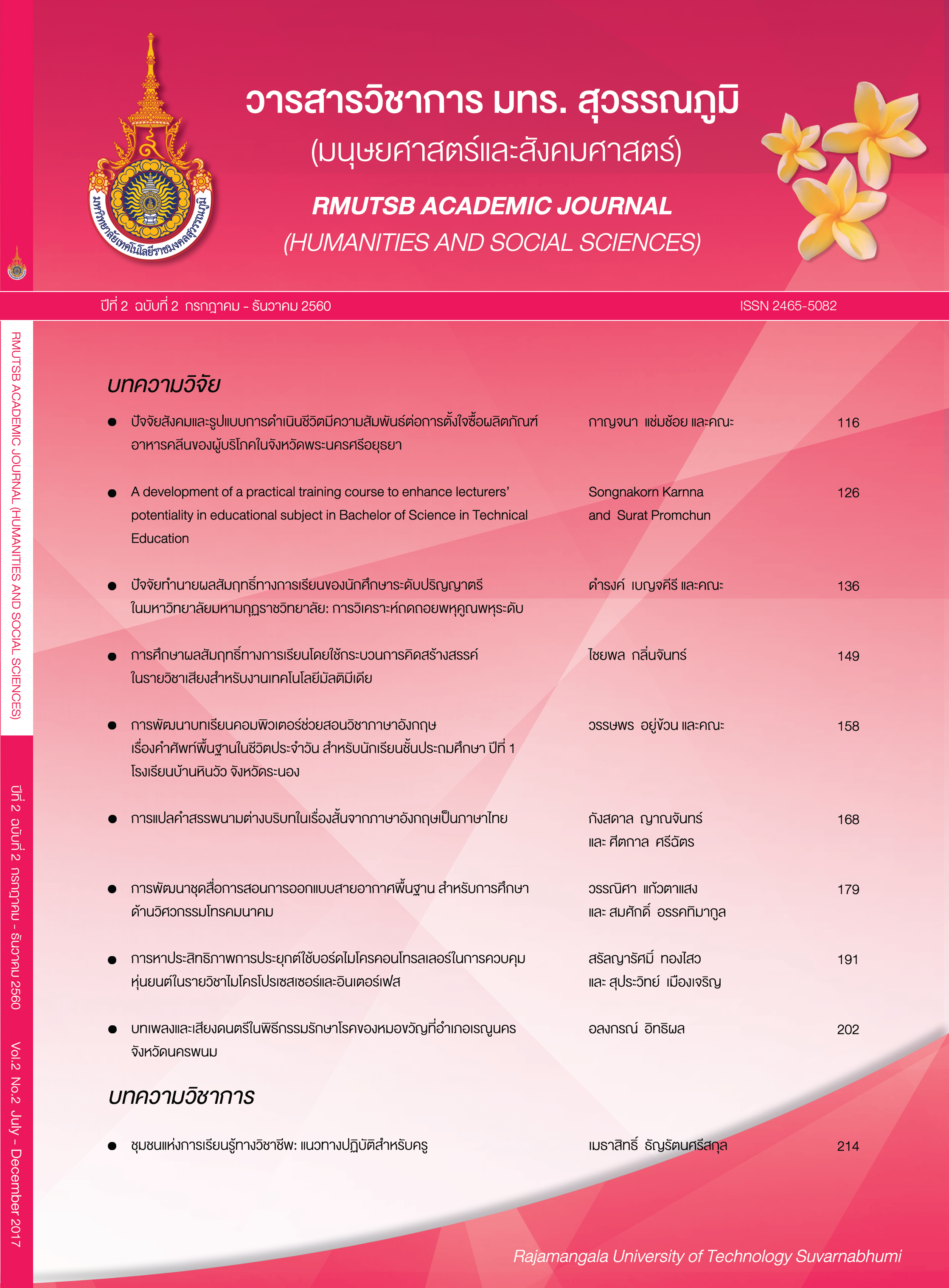ปัจจัยทำนายผลสัมฤทธิ์ทางการเรียนของนักศึกษาระดับปริญญาตรี ในมหาวิทยาลัยมหามกุฏราชวิทยาลัย: การวิเคราะห์ถดถอยพหุคูณพหุระดับ
Main Article Content
Abstract
การวิจัยมีวัตถุประสงค์เพื่อศึกษาปัจจัยทำนายพหุระดับและสร้างสมการทำนายพหุระดับที่ส่งผลต่อผลสัมฤทธิ์ทางการเรียนของนักศึกษาระดับปริญญาตรี ในมหาวิทยาลัยมหามกุฏราชวิทยาลัย กลุ่มตัวอย่างคือนักศึกษาระดับปริญญาตรี ชั้นปีที่ 1 ภาคเรียนที่ 1 ปีการศึกษา 2558 จำนวน 400 คน โดยวิธีการสุ่มแบบหลายขั้นตอน เครื่องมือที่ใช้เป็นแบบสอบถามประมาณค่า 5 ระดับ มีค่าความตรงเชิงเนื้อหา 0.67-1.00 ค่าอำนาจจำแนกรายข้อ 0.32-0.73 ค่าความเที่ยง 0.86 ปัจจัยที่ศึกษาคือปัจจัยระดับบุคคล และปัจจัยระดับสถานที่ตั้ง สถิติที่ใช้คือ การวิเคราะห์ถดถอยพหุคูณพหุระดับ 2 ระดับ ผลการวิจัยพบว่า (1) ปัจจัยที่สามารถทำนายผลสัมฤทธิ์ทางการเรียนในระดับบุคคล คือ นิสัยในการเรียน (LH) แรงจูงใจใฝ่สัมฤทธิ์ (AM) เจตคติต่อการเรียน (AL) การปรับตัวของนักศึกษา (AS) พฤติกรรมการสอนของผู้สอนตามการรับรู้ของผู้เรียน (TB) สื่อการเรียนการสอน (IM) และ (2) ปัจจัยที่สามารถทำนายผลสัมฤทธิ์ทางการเรียนในระดับสถานที่ตั้ง คือ ปัจจัยที่สามารถทำนายผลสัมฤทธิ์ทางการเรียนในระดับบุคคล คือ นิสัยในการเรียน (LH) แรงจูงใจใฝ่สัมฤทธิ์ (AM) เจตคติต่อการเรียน (AL) การปรับตัวของนักศึกษา (AS) พฤติกรรมการสอนของผู้สอนตามการรับรู้ของผู้เรียน (TB) สื่อการเรียนการสอน (IM) รายละเอียดดังสมการในรูปคะแนนมาตรฐาน ได้ดังนี้
การวิเคราะห์ระดับบุคคล (within model) สามารถทำนายได้ร้อยละ 56.40 (R2= 0.564)
Zˆ LAW = 0.178* ZLH - 0.155* ZAM + 0.080 ZAL + 0.684** ZAS + 0.042 ZTB - 0.006 ZIM
การวิเคราะห์ระดับสถานที่ตั้ง (between model) สามารถทำนายได้ร้อยละ 96.40 (R2= 0.964)
Zˆ LAIB = 0.781 ZLH - 0.868 ZAM - 1.375 ZAL + 1.262 ZAS + 0.238** ZTB + 0.885 ZIM
This research aims to study the factors predictor that affects multiple levels of learning achievement and to create a multi-level predictive equation that can affect the achievement of undergraduate students in the Mahamakut Buddhist University. The sample was the 1st year undergraduate students who enrolled in the first semester of the year 2015 which 400 were selected by multi stage random Sampling. The tool used in this study was a questionnaire about the five levels of content validity index values ranged from 0.67-1.00 the discriminative power from 0.32 - 0.73 and reliability of 0.86. The variables studied include individual levels and variable-level location. The statistics used for data analysis were a multiple regression multilevel analysis. The results showed that (1) the factors predicting student achievement are learning habit (LH), achievement motivation (AM), attitudes toward learning (AL), adaptation of students (AS), teaching behavior (TB), instructional media (IM), (2) the factors predicting location is learning habit (LH), achievement motivation (AM), attitudes toward learning (AL), adaptation of students (AS), and teaching behavior (TB), instructional media (IM). The standard equation was showed as followed;
within model that could predict to 56.40 percent (R2= 0.564)
Zˆ LAW = 0.178* ZLH - 0.155* ZAM + 0.080 ZAL + 0.684** ZAS + 0.042 ZTB - 0.006 ZIM
between model that could predict to 96.40 percent (R2= 0.964)
Zˆ LAIB = 0.781 ZLH - 0.868 ZAM - 1.375 ZAL + 1.262 ZAS + 0.238** ZTB + 0.885 ZIM


